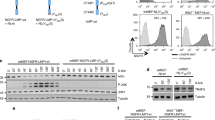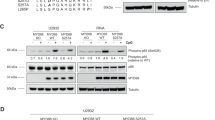Abstract
NF-κB signaling is required for the maintenance of normal B lymphocytes, whereas dysregulated NF-κB activation contributes to B cell lymphomas. The events that regulate NF-κB signaling in B lymphocytes are poorly defined. Here, we demonstrate that PKC-β is specifically required for B cell receptor (BCR)-mediated NF-κB activation. B cells from protein kinase C-β (PKC-β)-deficient mice failed to recruit the IκB kinase (IKK) complex into lipid rafts, activate IKK, degrade IκB or up-regulate NF-κB–dependent survival signals. Inhibition of PKC-β promoted cell death in B lymphomas characterized by exaggerated NF-κB activity. Together, these data define an essential role for PKC-β in BCR survival signaling and highlight PKC-β as a key therapeutic target for B-lineage malignancies.
This is a preview of subscription content, access via your institution
Access options
Subscribe to this journal
Receive 12 print issues and online access
$209.00 per year
only $17.42 per issue
Buy this article
- Purchase on Springer Link
- Instant access to full article PDF
Prices may be subject to local taxes which are calculated during checkout







Similar content being viewed by others
References
Karin, M. & Ben-Neriah, Y. Phosphorylation meets ubiquitination: the control of NF-κB activity. Annu. Rev. Immunol. 18, 621–663 (2000).
Ghosh, S., May, M.J. & Kopp, E.B. NF-κB and Rel proteins: evolutionarily conserved mediators of immune responses. Annu. Rev. Immunol. 16, 225–260 (1998).
Bendall, H.H., Sikes, M.L., Ballard, D.W. & Oltz, E.M. An intact NF-κB signaling pathway is required for maintenance of mature B cell subsets. Mol. Immunol. 36, 187–195 (1999).
Kaisho, T. et al. IκB kinase α is essential for mature B cell development and function. J. Exp. Med. 193, 417–426 (2001).
Senftleben, U. et al. Activation by IKKα of a second, evolutionary conserved, NF-κB signaling pathway. Science 293, 1495–1499 (2001).
Ren, H., Schmalstieg, A., Yuan, D. & Gaynor, R.B. IκB kinase β is critical for B cell proliferation and antibody response. J. Immunol. 168, 577–587 (2002).
Baldwin, A.S. Control of oncogenesis and cancer therapy resistance by the transcription factor NF-κB. J. Clin. Invest. 107, 241–246 (2001).
Rayet, B. & Gelinas, C. Aberrant Rel/NF-κB genes and activity in human cancer. Oncogene 18, 6938–6947 (1999).
Alizadeh, A.A. et al. Distinct types of diffuse large B-cell lymphoma identified by gene expression profiling. Nature 403, 503–511 (2000).
Davis, R.E., Brown, K.D., Siebenlist, U. & Staudt, L.M. Constitutive NF-κB activity is required for survival of activated B cell-like diffuse large B cell lymphoma cells. J. Exp. Med. 194, 1861–1874 (2001).
Pham, L.V. et al. A CD40 signalosome anchored in lipid rafts leads to constitutive activation of NF-κB and autonomous cell growth in B cell lymphomas. Immunity 16, 37–50 (2002).
Bajpai, U.D., Zhang, K., Teutsch, M., Sen, R. & Wortis, H.H. Bruton's tyrosine kinase links the B cell receptor to nuclear factor κB activation. J. Exp. Med. 191, 1735–1744 (2000).
Petro, J.B., Rahman, S.M., Ballard, D.W. & Khan, W.N. Bruton's tyrosine kinase is required for activation of IκB kinase and NF-κB in response to B cell receptor engagement. J. Exp. Med. 191, 1745–1754 (2000).
Rawlings, D.J. Bruton's tyrosine kinase controls a sustained calcium signal essential for B lineage development and function. Clin. Immunol. 91, 243–253 (1999).
Rawlings, D.J. & Witte, O.N. The Btk subfamily of cytoplasmic tyrosine kinases: structure, regulation and function. Semin. Immunol. 7, 237–246 (1995).
Rawlings, D.J. et al. Mutation of unique region of Bruton's tyrosine kinase in immunodeficient XID mice. Science 261, 358–361 (1993).
Leitges, M. et al. Immunodeficiency in protein kinase Cβ-deficient mice. Science 273, 788–791 (1996).
Newton, A.C. Regulation of protein kinase C. Curr. Opin. Cell. Biol. 9, 161–167 (1997).
Kawakami, Y. et al. Regulation of PKC-βI by two protein-tyrosine kinases, Btk and Syk. Proc. Natl. Acad. Sci. USA 97, 7423–7428 (2000).
Sun, Z. et al. PKC–θ is required for TCR-induced NF-κB activation in mature but not immature T lymphocytes. Nature 404, 402–407 (2000).
Krappmann, D., Patke, A., Heissmeyer, V. & Scheidereit, C. B-cell receptor- and phorbol ester-induced NF-κB and c-Jun N- terminal kinase activation in B cells requires novel protein kinase C's. Mol. Cell. Biol. 21, 6640–6650 (2001).
Miyamoto, A. et al. Increased proliferation of B cells and auto-immunity in mice lacking protein kinase Cδ. Nature 416, 865–869 (2002).
Mecklenbrauker, I., Saijo, K., Zheng, N.Y., Leitges, M. & Tarakhovsky, A. Protein kinase Cδ controls self-antigen-induced B-cell tolerance. Nature 416, 860–865 (2002).
Shipp, M.A. et al. Diffuse large B-cell lymphoma outcome prediction by gene-expression profiling and supervised machine learning. Nature Med. 8, 68–74 (2002).
Neuberger, M.S. Antigen receptor signaling gives lymphocytes a long life. Cell 90, 971–973 (1997).
Loder, F. et al. B cell development in the spleen takes place in discrete steps and is determined by the quality of B cell receptor-derived signals. J. Exp. Med. 190, 75–89 (1999).
Su, T.T. & Rawlings, D.J. Transitional B lymphocyte subsets operate as distinct checkpoints in murine splenic B cell development. J. Immunol. 168, 2101–2110 (2002).
Anderson, J.S., Teutsch, M., Dong, Z. & Wortis, H.H. An essential role for Bruton's tyrosine kinase in the regulation of B-cell apoptosis. Proc. Natl. Acad. Sci. USA 93, 10966–10971 (1996).
Choi, M.S., Holmann, M., Atkins, C.J. & Klaus, G.G. Expression of Bcl-x during mouse B cell differentiation and following activation by various stimuli. Eur. J. Immunol. 26, 676–682 (1996).
Solvason, N. et al. Transgene expression of Bcl-xL permits anti-immunoglobulin (Ig)-induced proliferation in XID B cells. J. Exp. Med. 187, 1081–1091 (1998).
Chen, C., Edelstein, L.C. & Gelinas, C. The Rel NF-κB family directly activates expression of the apoptosis inhibitor Bcl-xL . Mol. Cell. Biol. 20, 2687–2695 (2000).
Zandi, E., Rothwarf, D.M., Delhase, M., Hayakawa, M. & Karin, M. The IκB kinase complex (IKK) contains two kinase subunits, IKKθ and IKKβ, necessary for IκB phosphorylation and NF-κB activation. Cell 91, 243–252 (1997).
Fluckiger, A.C. et al. Btk/Tec kinases regulate sustained increases in intracellular Ca2+ following B-cell receptor activation. EMBO J. 17, 1973–1985 (1998).
Bi, K. & Altman, A. Membrane lipid microdomains and the role of PKC-θ in T cell activation. Semin. Immunol. 13, 139–146 (2001).
Guo, B., Kato, R.M., Garcia-Lloret, M., Wahl, M.I. & Rawlings, D.J. Engagement of the human pre-B cell receptor generates a lipid raft-dependent calcium signaling complex. Immunity 13, 243–253 (2000).
Cheng, P.C., Dykstra, M.L., Mitchell, R.N. & Pierce, S.K. A role for lipid rafts in B cell antigen receptor signaling and antigen targeting. J. Exp. Med. 190, 1549–1560 (1999).
Bi, K. et al. Antigen-induced translocation of PKC-θ to membrane rafts is required for T cell activation. Nature Immunol. 2, 556–563 (2001).
Rolink, A.G. et al. Mutations affecting either generation or survival of cells influence the pool size of mature B cells. Immunity 10, 619–628 (1999).
Cariappa, A., Kim, T.J. & Pillai, S. Accelerated emigration of B lymphocytes in the Xid mouse. J. Immunol. 162, 4417–4423 (1999).
Brorson, K. et al. XID affects events leading to B cell cycle entry. J. Immunol. 159, 135–143 (1997).
Leitges, M. et al. Targeted disruption of the PKC-ζ gene results in the impairment of the NF-κB pathway. Mol. Cell 8, 771–780 (2001).
Khoshnan, A., Bae, D., Tindell, C.A. & Nel, A.E. The physical association of protein kinase C θ with a lipid raft-associated inhibitor of κB factor kinase (IKK) complex plays a role in the activation of the NF-κB cascade by TCR and CD28. J. Immunol. 165, 6933–6940 (2000).
Das, K.C. & White, C.W. Activation of NF-κB by antineoplastic agents. Role of protein kinase C. J. Biol. Chem. 272, 14914–14920 (1997).
Cheng, Q., Lee, H.H., Li, Y., Parks, T.P. & Cheng, G. Upregulation of Bcl-x and Bfl-l as a potential mechanism of chemoresistance, which can be overcome by NF-κB inhibition. Oncogene 19, 4936–4940 (2000).
Ishii, H. et al. Amelioration of vascular dysfunctions in diabetic rats by an oral PKC-β inhibitor. Science 272, 728–731 (1996).
Teicher, B.A. et al. Antiangiogenic and antitumor effects of a protein kinase Cβ inhibitor in human T98G glioblastoma multiforme xenografts. Clin. Cancer Res. 7, 634–640 (2001).
Epstein, A.L. et al. Biology of the human malignant lymphomas. IV. Functional characterization of ten diffuse histiocytic lymphoma cell lines. Cancer 42, 2379–2391 (1978).
Tweeddale, M.E. et al. The presence of clonogenic cells in high-grade malignant lymphoma: a prognostic factor. Blood 69, 1307–1314 (1987).
Acknowledgements
We thank C. Sawyers, G. Cheng and A. Scharenberg for critical reading of the manuscript and members of the Rawlings lab for technical assistance and thoughtful discussions. Supported in part by NIH grants HD37091, CA81140, AI38348, AI33617 and CA74929 and the American Cancer Society. Also supported by the MSTP (GM08042) and Tumor Immunology (CA09120) Training Grants at UCLA (to T. T. S.); a Lymphoma Research Foundation Faculty Award (to M. T.); and a McDonnell Scholar Award, Leukemia and Lymphoma Society Scholar Award and the Joan J. Drake Grant for Excellence in Cancer Research (to D. J. R.).
Author information
Authors and Affiliations
Corresponding author
Ethics declarations
Competing interests
The authors declare no competing financial interests.
Rights and permissions
About this article
Cite this article
Su, T., Guo, B., Kawakami, Y. et al. PKC-β controls IκB kinase lipid raft recruitment and activation in response to BCR signaling. Nat Immunol 3, 780–786 (2002). https://doi.org/10.1038/ni823
Received:
Accepted:
Published:
Issue Date:
DOI: https://doi.org/10.1038/ni823
This article is cited by
-
Calcium-dependent signalling in B-cell lymphomas
Oncogene (2021)
-
Profiling transcriptomic changes and signaling pathways in atopic dermatitis by integrative analyses on multiple databases
Molecular Genetics and Genomics (2021)
-
Inhibition of effector B cells by ibrutinib in systemic sclerosis
Arthritis Research & Therapy (2020)
-
Targeting NF-κB pathway for the therapy of diseases: mechanism and clinical study
Signal Transduction and Targeted Therapy (2020)
-
A novel transgenic mouse strain expressing PKCβII demonstrates expansion of B1 and marginal zone B cell populations
Scientific Reports (2020)



